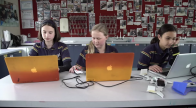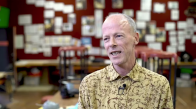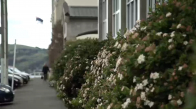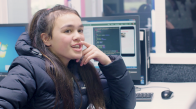Julie McMahon and Andrew Hornblow discuss the project, its drivers, and how simple and inexpensive electronics can be.
Learning with the internet of things: Overview of the programme
Transcript
Julie McMahon: Well the project that we’ve been involved in is called Pilot and we wanted students to learn about electronics and internet of things and be able to solve problems using their digital technology skills in a real-world context. And it all came about, about a year ago we had a summer workshop that was run by Andrew Hornblow and he came down as part of our Otago Robotics Community, and he did a workshop around using PICAXE boards and Raspberry Pi’s and getting students to actually see the physical computing, and being able to control those boards and use their programming skills to show the actual inputs and outputs.
And when I saw that when I took part in the workshop because there was students and teachers from primary school all the way to university level, I realised that it was really powerful because most of our students right now, they know how to swipe, they know how to click, they might know how to do a little bit of coding but they actually don’t understand what’s going on underneath the hood of their digital devices, and so this was a really powerful way to really reinforce what we’re trying to teach in digital technologies.
At that same workshop, there was somebody there from Orokonui eco sanctuary who was really interested in how we could use the devices in order to monitor some of the wildlife projects and I thought that would be a great scholarship programme for a student and it eventuated into being a scholarship project for one of our students at Kings who ended up getting top scholar. This has been a really powerful way to actually embed the new digital technology strands because within computational thinking, we have data representation and with data representation, with the PICAXE boards, they can actually see the circuits being turned on and off, so binary doesn’t just have to be some abstract concept, it’s actually we turn things off, we turn things on. So it brings in that data representation. They programme the board so that’s part of the programming strand, and they have to do the algorithmic thinking around how is that going to work? When do we want it to turn off, when do we want it to turn on? And they do the controls so it really sits well with the whole CT strand.
And with the designing and developing digital outcomes strand, obviously we’re taking that so it’s not just about controlling that device, it’s what can you do with the information that you gather from that device, so can you put that into a real-world context and that’s the whole point of designing and developing digital outcomes is we’re designing something for humans, we’re designing something for a purpose, and students are able to use these devices to design a myriad of different things in context. We’ve seen it have really good cross curricular links to maths and science, we see a variety of the projects that the students have done where they have embedded that within maybe a science fair project, or they’re having to do calculations and conversions. Also with creative digital technologies, because they’re mixing art with it and bringing in other things so it’s not just purely maths and science, but they can look at the whole range so it’s really strong in cross curricular links and cross technology.
Andrew Hornblow: I come from a background in the oil and gas industry, in Taranaki, and I’ve come in and really had all the fun, just bringing the ideas in. I have come in with really basic ideas starting with coin cells and LED through to using the solderless breadboard which means that circuits can be built in a class anywhere, you don’t require any special technical parts or anything like that and what I’ve found really encouraging myself, is seeing the way that students respond to just holding an LED and a button cell in their hands, and then adapting that to a breadboard and then putting a microcontroller beside it to make it do all sorts of things from an interactive toy, I think we did at year 7, a data logger at year 8, and then supporting other students around here, as Julie’s mentioned, right up to year 13 top scholarship project.
It’s really encouraging. People will recognise me in a class, or a conference, or any place when they see the margarine containers come out and the button cells and batteries and LEDs and a few jumper wires and my passion really has been to bring the technology right down to a level where you can pick a few pieces up off the table. It makes it really accessible for teachers, students. Usually it’s a case of the teachers trying to keep up with the students because the level of the tech is such that the kids really can take straight to it.
Related videos
Learning with the internet of things in years 7–8 (04:15)
Bill Boyes, Iain Cook-Bonney, and Tahuna Normal Intermediate School students talk about the wide range of digital technologies they can now make using their new skills....
Learning with the internet of things in years 5–6 (04:48)
Andrew Wills and the students at Bradford Primary School describe how they used their new knowledge in electronics to solve problems in their school....
Learning with the internet of things in years 9–10 (05:37)
Julie McMahon and Mark Greenfield discuss the application of electronics and the internet of things at St Hilda’s Collegiate and King's High School....
Creativity, critical thinking, and problem solving in digital technologies (03:16)
The digital technologies teacher, principal, and students discuss the success of the approach used to engage students, and in particular girls, in digital technologies. ...




